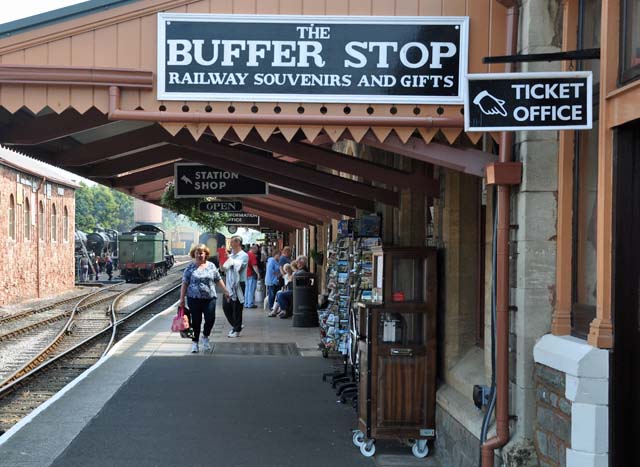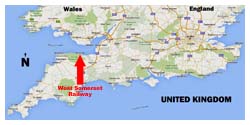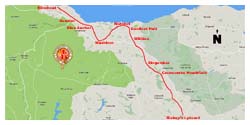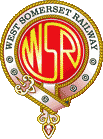
West Somerset Railway
The Railway Station
Minehead
Somerset
England
United Kingdom
N51.206983 W3.469732 (Station and parking lot)
 At 22 and 1/2 miles in length the West Somerset Railway is touted as the longest heritage railway in Britain. The line connects Bishops Lydeard and Minehead in the county of Somerset which lies west of London and south of Wales. A 3 mile extension from Bishops Lydeard connects with National Rail at Norton Fitzwarren where visiting locomotives may reach this heritage railway. A wye was constructed there with plans for the construction of a locomotive and rolling stock restoration depot in the future. With 10 stations between the two timetabled end points, Bishops Lydeard, Crowcombe Heathfield, Stogumber, Williton, Doniford Halt, Watchet, Washford, Blue Anchor, Dunster, and Minehead, the line's steepest grade is 1 in 65 (1.5 percent) with the summit located at Crowcombe Heathfield. The roster currently contains 13 steam locomotives and 11 diesel locomotives. The locomotive sheds are located at Minehead. Trains (generally) operate between 10:00 and 16:00 from March to October with December specials. Check their web site for the exact date you wish to travel.
At 22 and 1/2 miles in length the West Somerset Railway is touted as the longest heritage railway in Britain. The line connects Bishops Lydeard and Minehead in the county of Somerset which lies west of London and south of Wales. A 3 mile extension from Bishops Lydeard connects with National Rail at Norton Fitzwarren where visiting locomotives may reach this heritage railway. A wye was constructed there with plans for the construction of a locomotive and rolling stock restoration depot in the future. With 10 stations between the two timetabled end points, Bishops Lydeard, Crowcombe Heathfield, Stogumber, Williton, Doniford Halt, Watchet, Washford, Blue Anchor, Dunster, and Minehead, the line's steepest grade is 1 in 65 (1.5 percent) with the summit located at Crowcombe Heathfield. The roster currently contains 13 steam locomotives and 11 diesel locomotives. The locomotive sheds are located at Minehead. Trains (generally) operate between 10:00 and 16:00 from March to October with December specials. Check their web site for the exact date you wish to travel.
- 1857 - West Somerset Railway Company incorporated;
- 1862 - 7 foot gauge line opened between Taunton and Watchet;
- 1874 - Line extended to Minehead;
- 1882 - Converted to Standard gauge 4 feet 8 1/2 inches;
- 1897 - Absorbed into the Great Western Railway;
- 1948 - Great Western Nationalized;
- 1956 - Minehead engine shed closed;
- 1967 - Original turntable removed from Minehead;
- 1971 - Line closed;
- 1971 - New West Somerset Railway Plc formed to purchase line;
- 1973 - Somerset County Council purchases right-of-way;
- 1973 - Right-of-way leased to West Somerset Railway Plc;
- 1976 - Heritage trains operate between Minehead and Williton;
- 1978 - Heritage trains now reach Stogumber;
- 1979 - Heritage trains reach Bishops Lydeard;
- 2008 - New turntable operational at Minehead;
- 2009 - New station built at Norton Fitzwarren;
- 2013 - West Somerset Railway Plc offer to purchase right-of-way;
- 2014 - Somerset County Council cancels right-of-way sale.
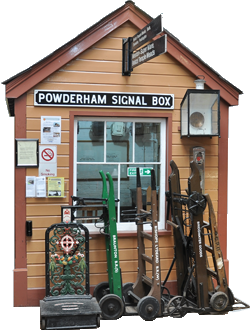 The Powderham Signal Box exhibit is located in the Gauge Museum at Bishops Lydeard station.
The Powderham Signal Box exhibit is located in the Gauge Museum at Bishops Lydeard station.
Powderham was one of the GWR's small "break-section" signal boxes on the main line between Exeter and Newton Abbot.
It was opened in 1924 to provide greater capacity on Summer Saturdays for the intensive service of holiday trains to and from the Devon and Cornwall resorts.
The signal box was situated on the edge of the picturesque Exe Estuary and must have been a fantastic place to work. The boxes either side of it were Exminster (to the north) and Starcross (to the south). The signalman at Powderham would have been in close communication with the men at these other signal boxes to allow trains safe passage along the line.
This Gauge Museum display is a recreation of what Powderham might have looked like in the late 1950s, though we have taken some artistic licence. The Up line signals are colour-lights, the Down line signals are semaphores.
The signal box plays an important role in safe railway travel. In early days, trains were prevented from crashing into one another by time intervals. The signalman, waving flags or batons, allowed a train to proceed after a specified time gap since the previous one, despite the fact that it may have broken down just around the corner. Points were manually operated to switch trains from one line to another.
The invention of the electric telegraph in the 1850s allowed signalmen to send an electric bell code down the line to say when the line was clear for a train. This was called the "block system". By this time, signals and points were mechanically controlled from the signal box and interlocked together to prevent conflicting moves being made.

There are 13 steam locomotives located on the railway. Please refer to their web site for their latest operating condition.
GWR 4110 - 2-6-2T.
GWR 4561 - 2-6-2T.
GWR 4936 - 4-6-0 "Kinlet Hall".
BR 7821 - 4-6-0 "Ditcheat Manor";.
BR 7828 - 4-6-0 "Odney Manor".
GWR 6024 - 4-6-0 "King Edward I".
GWR 6695 - 0-6-2T.
GWR 6960 - 4-6-0 "Raveningham Hall".
WSR 9351 - 2-6-0.
SDJR 53808 - 2-8-0.
SDJR 53809 - 2-8-0.
SDJR 1788 - 0-4-0ST "Kilmersdon".
LMS 44422 - 0-6-0.
Additionally, there are eleven diesel-electric locomotives.
Great Western Railway Sleeping Car 9038 was one of three built by in 1897 to carry First Class passengers between Paddington Station in London and the port of Fishguard for the ferry to Ireland. 9038 actually rolled off the production line at Swindon on 26 Dec 1896. The vehicle was the height of GWR luxury and each compartment was fitted with tip-up sinks so that passengers could wash in privacy.
The sleeper has eight single berth compartments. Each pair of compartments has a communicating door so that couples could be accommodated. There is a central sitting area that has only six seats, so not everyone could sit down at once. One end of the coach has the lavatory compartment and at the other end was the car attendant's pantry where water was heated for the sinks, and snacks and drinks could be prepared.
Each compartment was linked to the pantry by an electric bell so the attendant could be summoned by the passengers at any hour of the day or night.
Sleeper 9038 was withdrawn from service in 1931 when it was replaced by more modern and economic rolling stock. In 1933, it was sold to become part of a bungalow at Stogursey, near Bridgwater, this being an easy way to construct a rather luxurious house. The coach was taken to Bridgwater by train where the body was separated from the chassis and loaded onto the trailer of a steam lorry. It was then maneuvered through the streets to its resting place.
Over the years a well-built pantile roofed bungalow was built over the sleeper which was raised well clear of the ground on brick pillars. The new bungalow was appropriately named "Journey's End" and became something of a local landmark. The roof of the bungalow partly rested on the sleeper's roof and this solid structure ensured the sleeper's preservation over the years. Not a bit of rot was found in the oak frame when the vehicle was restored. It seemed as if the sleeping car was finally retired at this point.
Restoration

By 1984, the owner of the bungalow decided that he had no further use for the sleeper and it was offered to the West Somerset Railway. As the vehicle was so important, and in such good condition, this was an offer too good to miss.
In 1986 the bungalow was pulled apart releasing the old sleeper. Moving it from the field was difficult, it being necessary to take care to avoid damaging the vehicle. It was taken by road to Bishops Lydeard.
The first task was to find a new chassis for the body and in the spring of 1985 a Great Western coach underframe from 1934 became available. At the same time, the West Somerset Steam Railway Trust was lucky enough to be given parts from sister sleeper, 9039, which was being dismantled at Didcot. With the necessary parts available, complete restoration now seemed possible.
The sleeper was at Bishops Lydeard until 1992 and during this period work mostly concentrated on stripping the old canvas from the roof and recovering it with new material. In September 1992 the coach was moved into the new restoration building at Williton. Now under cover work could progress much faster. The exterior cladding on the corridor side of the sleeper had to be completely stripped off and replaced. The doors, which had been removed in 1933 but luckily used in a coal shed, had to be renovated and refitted.
Compartment number 1 was still in place with its tip-up washbasin but there was a bath where the bed should be. Other compartments had been removed in the bungalow days and had to be rebuilt with parts from sister 9039. This included removing many layers of old wallpaper and paint. The walls were re-varnished to the correct aged mahogany colour. Perhaps the hardest and least pleasant part of the work was cleaning the many layers of paint off the ceiling and revealing the original "bunches of grapes" embossed pattern. This one job alone took more than eighteen months.
There were many other tasks including making and refitting door handles and other fittings, the manufacture of new window blinds from specially woven material, the ordering and fitting of the correct style Sugg gas lamps, and many other expensive jobs. The final task was to paint and line the exterior which was magnificently done by Bob Timmins.
Sleeping Car 9038 was officially unveiled and returned to traffic in May 2006.
As of 2016 Sleeping Car 9038 resides within the Gauge Museum opposite Bishops Lydeard station.
22 Mar 2009 - Lorry Carrying Locomotive Catches Fire on M5
11 May 2010 - Tornado to Steam Into Minehead
19 May 2012 - West Somerset Railway Guard Celebrates 30th Anniversary
2 Aug 2012 - Railway Book Shop at Minehead Raises £150,000
20 Jan 2013 - Row Over Free Travel on West Somerset Railway
10 Feb 2014 - Somerset County Council Could Sell Heritage Railway
10 Jun 2014 - No Sale of WSR Freehold by County Council
29 Aug 2014 - Professor Stephen Hawking Visits the West Somerset Railway
8 Nov 2014 - Plans to Link the WSR with Taunton Are Being Discussed
19 Mar 2015 - Lorry Collapses Under Weight of 65 Tonne Steam Locomotive
25 Aug 2015 - Severn Valley Railway Pair to Visit WSR Autumn Gala
10 Sep 2015 - Rail Chief's Carriage Back on the Line
9 Dec 2015 - Trustees of WSRA Told to Step Down
30 Dec 2015 - Railway Trainees on Track After Completing Apprenticeships
29 Feb 2016 - Quantock Brewery Launches New Beer
2 Mar 2016 - West Somerset Railway Association Votes Out Trustees
2 Mar 2016 - WSR Spring Steam Gala Gets Underway
9 Mar 2016 - Man Crushed Between Locomotive and Tender
18 May 2016 - WSR Trains Halted After Military Device Found
19 May 2016 - Railway Staff Commended After Watchet Bomb Scare






West Somerset Railway
West Somerset Railway Association
Hawksworth Saloon
wsr.org.uk
Somerset & Dorset Railway Trust
44422 Locomotive Company Ltd.
The Story of the GWR
GWR Archive
GWR Modelling
Didcot Railway Centre
National Rail
Great Western Railway
 West Somerset RailwayC.R. Clinker1980Exmoor Press DulvertonPaperback64 pages, US$9.13 AmazonA history in pictures with an account by C.R. Clinker illustrated with black and white photos. The making of a railway from the Bristol and Exeter Railway at Taunton to Watchet in Somerset. A short textual history.
West Somerset RailwayC.R. Clinker1980Exmoor Press DulvertonPaperback64 pages, US$9.13 AmazonA history in pictures with an account by C.R. Clinker illustrated with black and white photos. The making of a railway from the Bristol and Exeter Railway at Taunton to Watchet in Somerset. A short textual history. Minehead Branch and the West Somerset Railway, TheColin G. Maggs1998Oakwood PressSoftcover176 pages, £12.95Well known author on railway matters in the West Country Colin Maggs tells the story of one of the GWR's longest branch lines, from its beginnings in the 1830s to later times when many thousands of holiday makers would arrive to enjoy a week by the seaside at Billy Butlin's holiday camp.
Minehead Branch and the West Somerset Railway, TheColin G. Maggs1998Oakwood PressSoftcover176 pages, £12.95Well known author on railway matters in the West Country Colin Maggs tells the story of one of the GWR's longest branch lines, from its beginnings in the 1830s to later times when many thousands of holiday makers would arrive to enjoy a week by the seaside at Billy Butlin's holiday camp. West Somerset Railway A View from the PastRichard Jones1998Ian Allan Ltd.Paperback96 pages, £12.00A pictorial history illustrated with black and white photographs, gradient profiles, and route maps.
West Somerset Railway A View from the PastRichard Jones1998Ian Allan Ltd.Paperback96 pages, £12.00A pictorial history illustrated with black and white photographs, gradient profiles, and route maps. West Somerset Railway Volume 1, TheJohn Stretton2000Past & Present Publishing Ltd.Paperback128 pages, $18.57Running from Bishops Lydeard near Taunton to Minehead, at over 21 miles the WSR is the longest preserved line in the UK, so fully deserves to be classed among the premier heritage railways. It incorporates many of the classic ingredients of a traditional GWR branch line, steam-hauled trains and beautiful stations set in an idyllic countryside of rolling hills and seaside resorts.
West Somerset Railway Volume 1, TheJohn Stretton2000Past & Present Publishing Ltd.Paperback128 pages, $18.57Running from Bishops Lydeard near Taunton to Minehead, at over 21 miles the WSR is the longest preserved line in the UK, so fully deserves to be classed among the premier heritage railways. It incorporates many of the classic ingredients of a traditional GWR branch line, steam-hauled trains and beautiful stations set in an idyllic countryside of rolling hills and seaside resorts. West Somerset Railway Memories Volume 1Charles Kinsey2006Charles KinseyPaperback128 pages, £34.50Colour photographs with captions.
West Somerset Railway Memories Volume 1Charles Kinsey2006Charles KinseyPaperback128 pages, £34.50Colour photographs with captions. Return Ticket to Minehead: Further Recollections
Return Ticket to Minehead: Further Recollectionsof the West Somerset RailwayAlan Hammond, Christine Hammond, Richard Derry2007Millstream BooksSoftcover144 pages, £29.21Features 15 memories of life on the West Somerset Railway and in the Taunton-Minehead area from the early 1900s to 1971. This work also includes railway workings at Taunton in the 1980s. It is illustrated with 150 black and white photographs.
 West Somerset Railway in ColourTony Whitby2009Ian Allan PublishingHardcover80 pages, US$38.40The West Somerset Railway runs from Bishops Lydeard to Minehead, and at 23 miles is the country's longest standard-gauge preserved railway. Originally a GWR branch line that linked to the main network just to the west of Taunton, the line was closed on 4 Jan 1971. It was subsequently acquired for preservation and for the last thirty years popular tourist services have operated over the route. The line retains a main-line connection, and over the years, this has been used for the operation of a number of through specials from the national network. The line has also played host to a number of high profile guest locomotives.
West Somerset Railway in ColourTony Whitby2009Ian Allan PublishingHardcover80 pages, US$38.40The West Somerset Railway runs from Bishops Lydeard to Minehead, and at 23 miles is the country's longest standard-gauge preserved railway. Originally a GWR branch line that linked to the main network just to the west of Taunton, the line was closed on 4 Jan 1971. It was subsequently acquired for preservation and for the last thirty years popular tourist services have operated over the route. The line retains a main-line connection, and over the years, this has been used for the operation of a number of through specials from the national network. The line has also played host to a number of high profile guest locomotives. Spirit of the West Somerset RailwayDon Bishop2009Halsgrove PublishingHardback64 pages, 60 photos, £4.99Don Bishop has captured the line working through all the seasons over some 18 years with a particular emphasis on steam in the landscape shots, particularly in the months between October and April when the light is at its best, the sun lower in the sky, and crisper. A great variety of steam locomotives that have worked over the line in recent years is seen, ranging from single coach Auto trains to through excursions from the national network. More than 60 photographs included in this ground-breaking pocket-format book vividly portray Britain's longest preserved steam line.
Spirit of the West Somerset RailwayDon Bishop2009Halsgrove PublishingHardback64 pages, 60 photos, £4.99Don Bishop has captured the line working through all the seasons over some 18 years with a particular emphasis on steam in the landscape shots, particularly in the months between October and April when the light is at its best, the sun lower in the sky, and crisper. A great variety of steam locomotives that have worked over the line in recent years is seen, ranging from single coach Auto trains to through excursions from the national network. More than 60 photographs included in this ground-breaking pocket-format book vividly portray Britain's longest preserved steam line.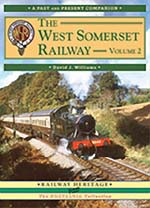 West Somerset Railway Volume 2, TheDavid Williams2009Silver Link Publishing Ltd.Paperback96 pages, £16.99Photographs of the West Somerset railway taken during the last six years at Enthusiasts weekends. All stations featured plus some line side photos. Over 40 locomotives featured.
West Somerset Railway Volume 2, TheDavid Williams2009Silver Link Publishing Ltd.Paperback96 pages, £16.99Photographs of the West Somerset railway taken during the last six years at Enthusiasts weekends. All stations featured plus some line side photos. Over 40 locomotives featured. The West Somerset Railway RevisitedDon Bishop2010Halsgrove PublishingHardcover144 pages, £13.75Since the publication of Don Bishop's first book on the WSR in 2005 the railway has continued to grow and develop. Passenger numbers have continued to rise. At least two major special events each year attract guest locomotives to the line. A good variety of motive power has appeared and is featured in this book. They include the first visit of an LNER A4 Pacific, Royal Scot, and of course the new build A1 Tornado which spent three weeks on the line during 2009. More modern motive power is also featured with the Western Region's diesel hydraulic classes to the fore. This new volume aims to show the WSR at its best running through the wonderful countryside and coast that surrounds it. All of the images were taken between 2004 and 2009 so show the line in its most recent form.
The West Somerset Railway RevisitedDon Bishop2010Halsgrove PublishingHardcover144 pages, £13.75Since the publication of Don Bishop's first book on the WSR in 2005 the railway has continued to grow and develop. Passenger numbers have continued to rise. At least two major special events each year attract guest locomotives to the line. A good variety of motive power has appeared and is featured in this book. They include the first visit of an LNER A4 Pacific, Royal Scot, and of course the new build A1 Tornado which spent three weeks on the line during 2009. More modern motive power is also featured with the Western Region's diesel hydraulic classes to the fore. This new volume aims to show the WSR at its best running through the wonderful countryside and coast that surrounds it. All of the images were taken between 2004 and 2009 so show the line in its most recent form. West Somerset Railway Guide BookJohn Simms2016Silver Link Publishing Ltd.Paperback64 pages, £4.00The official West Somerset Railway Guide Book is one of a set of three comprehensive books that Silver Link are pleased to produce for the railway.
West Somerset Railway Guide BookJohn Simms2016Silver Link Publishing Ltd.Paperback64 pages, £4.00The official West Somerset Railway Guide Book is one of a set of three comprehensive books that Silver Link are pleased to produce for the railway. West Somerset Railway Stock Book
West Somerset Railway Stock Bookand Spotters GuideKeith Smith2016Silver Link Publishing Ltd.Paperback64 pages, £4.63Locomotives, coaching stock, goods wagons, and other miscellaneous equipment resident on the railway, as at January 2016, are fully described. An effort has been made to present a reasonable up-to-date history and technical appraisal of all items in the collection wherever possible. With such a large operational railway, changes in the rolling stock register are frequent, new items arrive, while others depart, some are stored for overhaul while others are restored to their former glory.
 West Somerset Railway Country Walks
West Somerset Railway Country Walksfrom Our StationsMalcolm Short2016Silver Link Publishing Ltd.Paperback64 pages, £5.00Each station along the line Is the starting point for a walk. Detailed text explains the route to follow and illustrations that accompany each provide reference points to ensure you are on the right track, no pun intended.


